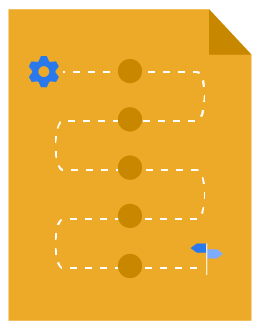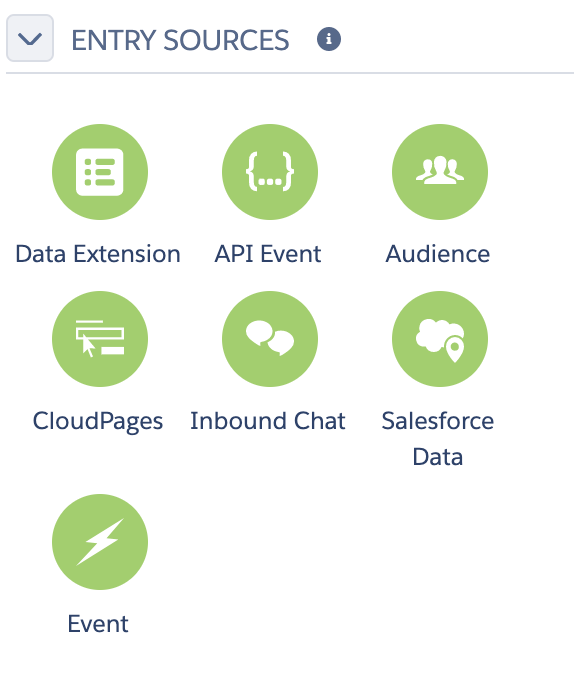Every customer journey needs to start somewhere. Before you start building any customer journeys, it’s important to ask yourself: where are my contacts going to come from and how are they going to enter the journey?
Without defining these 2 criteria first, you risk creating customer journeys that aren’t personalized to your contacts.
In this chapter, you’ll learn:
- The different entry sources in Journey Builder
- Use cases for each entry source
- Limitations of each entry source
Let’s start out by defining what an entry source is.

Download Salesforce Marketing Cloud Journey Builder: The Essential Guide
Download our Salesforce Marketing Cloud Journey Builder: The Essential Guide to maximize your marketing automation platform.
What are Journey Builder’s entry sources?
An entry source in Journey Builder determines how your contacts get injected into your journey based on where your contact data is stored. This data can come from a variety of places, such as a data extension in Marketing Cloud or even from a different Salesforce app. As mentioned in the previous chapter, you’ll want to be deliberate with who you are going to target with the customer journey.
Here are the different entry sources you can choose from in Journey Builder. Keep in mind that only some sources may be available to you depending on your Marketing Cloud edition:

- Data extension
- API event
- Salesforce data
- Inbound chat message
- Audience Studio
- Google Analytics 360
- CloudPages
- Event
- Audience
Now, we’re going to take a deep dive into the different entry sources, their use cases, and their limitations.
Data extension
You can use a data extension as an entry source when you have your contacts’ information stored in a table within Marketing Cloud.
This is one of our digital marketers’ most commonly used entry sources because of its flexibility. You can use the data extension filters to control which contacts are allowed to join your journey — or you can even admit all contacts from your data extension at once.
With data extensions, you can:
- Admit contacts in batches
- Segment the audience based on custom criteria
- Use data to personalize your content
- Schedule when contacts can be admitted
You can use a data extension as an entry source when you have your contacts’ information stored in a table within Marketing Cloud.
This is one of our digital marketers’ most commonly used entry sources because of its flexibility. You can use the data extension filters to control which contacts are allowed to join your journey — or you can even admit all contacts from your data extension at once.
With data extensions, you can:
API events
As mentioned above, API events are made for quick real-time trigger sends based on data that’s stored in another platform or system. This is ideal for admitting new contacts into journeys based on how they interacted with your website — assuming that your website isn’t already integrated with Marketing Cloud. In order for Marketing Cloud to store contact records, you’ll still need a data extension.
To set up the API event entry source, you’ll need to first copy the event definition key that Journey Builder provides for the journey. Then, you’ll paste it into the other system that you’re connecting.
The most common example of using API events as an entry source is triggering receipt sends. Since API events can be fired immediately, our digital marketers enjoy how you can send your customer a receipt as soon as they make a purchase on your website or other point of sale system.
However, be aware that the biggest limitation to using API events is that it can’t execute batch sends because API can only send one record at a time.
Salesforce data
Another popular entry source is Salesforce data. This entry source can be used to create a recipient list based on records created or modified in Salesforce Sales Cloud or Service Cloud CRM.
The 3 entry source options are:
- Salesforce Community Welcome: Used with Experience Cloud to welcome new community members.
- Salesforce Campaign: Used to power a journey based on your existing Salesforce campaigns and campaign members.
- Salesforce Data: Includes any other subscribers from your Salesforce CRM, such as leads, contacts, and custom objects.
Just like any other entry source, there are some limitations to using Salesforce data as an entry source. You must first have Marketing Cloud integrated with your CRM through Marketing Cloud Connect. Furthermore, Salesforce data isn’t ideal for a batch send that requires complex personalization.
Inbound chat message
As the name suggests, inbound chat message as an entry source is great for mobile chatting purposes.
You’ll need a WhatsApp Business Account to use inbound chat message as an entry source. From there, you must connect your WhatsApp channel with a Facebook Business Manager account.
Once connected, the entry source will use your targeted keywords to admit your contacts. You’ll be able to add up to 10 keywords. When your contacts send one of those specified keywords, they are entered into the journey.
Due to its primary focus on mobile users, inbound chat message is considered one of the most limiting entry sources. However, it’s a great option for those who are looking to directly chat with their contacts using WhatsApp messages.
Audience Studio
Previously known as Salesforce DMP (Data Management Platform), Audience Studio unifies data from all your sources. As an entry source, it’s great for cross-channel promotional campaigns — such as a mix of emails, mobile, and advertising.
You can use an audience from Audience Studio within Journey Builder as an entry source, which allows you to target audiences from across your channels. From there, you can use filters within Journey Builder to choose either which contacts to admit or admit all at once.
Google Analytics 360
Looking to pair your Google Analytics insights with Journey Builder? You’ll first need to have audiences configured in your Google Analytics account and be able to use these audiences within Marketing Cloud.
As an entry source, Google Analytics 360 will only inject contacts that are in both Google Analytics and Salesforce Marketing Cloud into the customer journey. Once set up, you can use this entry source to send targeted messages or ads to the specified audience.
Another use case of using Google Analytics 360 is honoring opt-out requests for personalized ads. You’ll have to use a decision split immediately after the entry source, which can analyze who has withdrawn consent for personalized ads. That way, the journey will stop these contacts from receiving additional personalized ads.
This entry source is ideal for those who are looking to retarget website visitors. Unfortunately, its biggest limitation is that Google Analytics 360 won’t be able to target unknown visitors who don’t have any record in Marketing Cloud.
CloudPages
CloudPages is an out-of-the-box landing page builder in Marketing Cloud. Use Smart Capture forms on CloudPages as an entry source to target those who have filled out a form on your website. Once they fill out the form, they are automatically queued to enter the journey.
Since CloudPages is an older Journey Builder feature, our digital marketers rarely use CloudPages as an entry source. We recommend using another entry source and a more intuitive form builder.
Event
Event is an entry source that uses customer behavior data to inject contacts into a journey. Contacts are added into this journey when there is a change in the customer’s data that triggers an evaluation of that contact. If your contact performs an action that meets your criteria, they’ll be admitted into the journey.
Some common use cases include:
- When a contact signs up for a webinar
- When a contact publishes a review
- When a contact opts into receiving promotional messages
Audience
Though it’s not as commonly used as other entry sources, the Audience entry source can be helpful if you want to inject audiences from Audience Builder into your journey.
If you don’t use Audience Builder or it’s not in your Marketing Cloud lineup, you can still use Audience as an entry source for Mobile Lists created in Mobile Studio. Then, you can use your Mobile Lists to send out push mobile notifications or SMS messages to your subscribers.
Be aware that Audience is not ideal for highly targeted and personalized communications. We recommend using data extensions for Mobile Lists rather than using Audience as an entry source for better results.

Download Salesforce Marketing Cloud Journey Builder: The Essential Guide
Download our Salesforce Marketing Cloud Journey Builder: The Essential Guide to maximize your marketing automation platform.
Rounding up all the entry sources
Entry sources determine who you’re going to target and how they’ll enter your journey. Being intentional about which entry source to choose will help you target contacts better through your journeys.
The entry source options within Journey Builder are:
- Data extension
- API event
- Salesforce data
- Inbound chat message
- Audience Studio
- Google Analytics 360
- CloudPages
- Event
- Audience
It’s important to remember that with Journey Builder’s flexibility comes complexity. Many entry sources require advanced setup and a full understanding of your data model. This is why we recommend hiring a seasoned digital marketer who lives and breathes Salesforce Marketing Cloud to run your customer journeys.
Looking to hire additional help? EBQ’s marketing team can run your Marketing Cloud strategy and even create branded assets to boost brand awareness. To learn more, explore our Marketing Cloud services.



